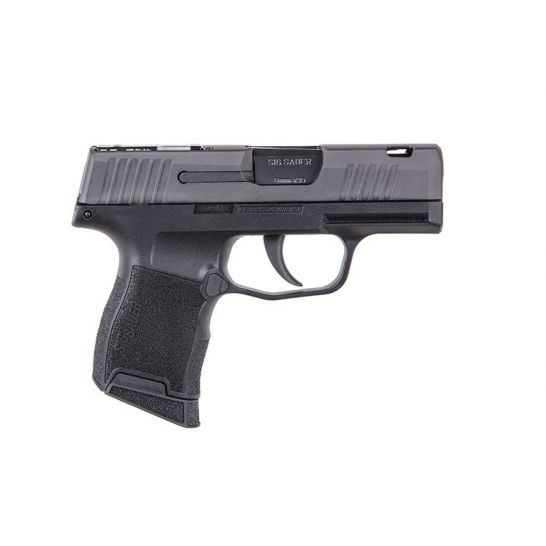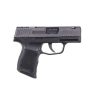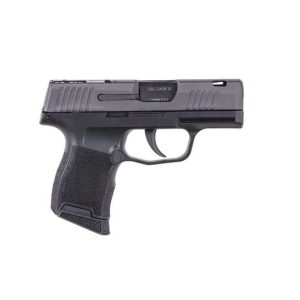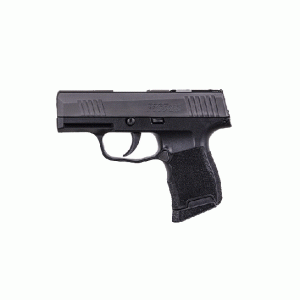SIG Sauer P365 SAS Micro Compact 9mm Pistol (1 EXTRA MAGAZINE FROM SIG FOR FREE) For Sale
$579.99
The SIG Sauer P365 SAS Micro Compact 9mm Pistol is a cutting-edge firearm tailored for concealed carry users, offering enhanced draw smoothness, rapid sight acquisition, and performance optimized for practical engagement ranges. It features the innovative SIG Anti Snag (SAS) treatment and incorporates the groundbreaking FT Bullseye sight directly into the slide, eliminating the traditional front sight to minimize snag risks while providing a clear, high-visibility sight picture with fiber optic and tritium enhancements. The P365 SAS boasts a ported barrel and slide to reduce muzzle flip, flat controls, and flush-mounted features for smooth sides, all contributing to a cleaner, snag-free shooting experience. With a crisp trigger pull and a striker-fired system, it ensures reliability and user-friendliness. The pistol package includes a Flush-Mounted FT Bullseye Fiber-Tritium Night Sight, an extra magazine, and an unmatched approach to sight mechanics, offering superior value and preparedness.
What is the difference between P365 and P365 SAS?
The primary difference between the Sig Sauer P365 and the P365 SAS (Sig Anti-Snag) lies in their design purpose and features aimed at reducing snag and improving concealability:
1. **Sights:**
– *P365*: Comes with standard night sights, which are raised.
– *P365 SAS*: Features the FT Bullseye sight, which is flush-mounted to reduce the potential for snagging when drawn from concealment.
2. **Slide:**
– *P365*: Has a standard slide with external controls.
– *P365 SAS*: The slide is ported for recoil reduction and has no front sight cuts, maintaining a sleek profile.
3. **Controls:**
– *P365*: Standard external slide lock lever and takedown lever.
– *P365 SAS*: Minimalistic controls to prevent snagging, including a recessed slide lock and takedown levers.
The P365 SAS is designed for ultra-concealability and snag-free operation, making it ideal for concealed carry users who prioritize smooth draws and minimal printing.
What does SAS mean on SIG P365?
On the SIG P365, “SAS” stands for “SIG Anti-Snag.” It refers to a specific model variant designed to have a smooth profile with no protruding sights or controls that could catch on clothing or other materials, making it ideal for concealed carry. The SAS model often features innovative design elements to minimize snag potential.
Is a SIG better than a Glock?
The comparison between SIG Sauer and Glock firearms is subjective and depends on personal preferences and intended use. Both brands are reputable and popular among law enforcement, military, and civilian users. Here are a few considerations for each:
**SIG Sauer:**
– Known for high-quality manufacturing and reliability.
– Offers a diverse range of models with various features.
– Some models, like the SIG P320, offer modularity, allowing users to customize grip size and other components.
**Glock:**
– Celebrated for simplicity, durability, and ease of use.
– Often preferred for its lower weight and polymer construction.
– Known for having a consistent trigger pull and fewer external controls.
Ultimately, deciding whether a SIG or Glock is “better” depends on individual criteria such as ergonomics, budget, aesthetic preferences, and specific use cases (e.g., personal defense, competitive shooting). It’s advisable to test both brands to see which model feels more comfortable and suits your needs better.
Is the SIG P365 better than Glock?
Determining whether the SIG P365 is “better” than a Glock depends on various factors including personal preference, intended use, and specific model comparisons. Here are some considerations:
1. **Size and Concealability**: The SIG P365 is known for its compact size and high capacity for concealed carry. If you prioritize a smaller profile for easier concealment, the P365 might be more to your liking compared to larger Glock models.
2. **Capacity**: The P365 boasts a high capacity (10+1, 12+1, or even 15+1) in a small frame, which is a significant advantage for a compact pistol. Glock also offers models with high capacity, but typically they are larger in size.
3. **Ergonomics and Grip**: Personal comfort and hand fit vary between brands and models. Some users prefer the grip angle and texture of the SIG P365 while others prefer Glock’s design. It’s subjective and trying both is recommended.
4. **Trigger**: The trigger feels different between the two brands. SIG’s P365 has a reputation for a smooth trigger pull, while Glock triggers might be described as more consistent across different models.
5. **Reliability**: Both SIG and Glock are known for their reliability and durability. Glock has a long-standing reputation in the law enforcement and military community, while SIG has received positive reviews for the P365.
6. **Price**: Pricing can vary but often the SIG P365 might be slightly more expensive than comparable Glock models.
Ultimately, “better” is subjective and based largely on what qualities are most important to you in a firearm. Test firing both at a range would provide the best sense of which suits your preferences and needs.
What does the P stand for in Sig Sauer P365?
The “P” in Sig Sauer P365 stands for “Pistol.”
How much does a P365 cost?
The cost of a SIG Sauer P365 can vary depending on several factors, including the specific model, location, and retailer. As of the latest information, the base model of the P365 generally ranges from approximately $500 to $600. Prices can be higher for models with additional features or packages. To get the most accurate and up-to-date pricing, it’s best to check with local gun shops, online retailers, or SIG Sauer’s official website.
What model sig do navy SEALs use?
Navy SEALs typically use the SIG Sauer P226. This handgun is favored for its reliability and durability in various conditions and is chambered in 9mm. It has been a standard sidearm for many SEAL teams for years.
What are the cons of the Sig P365?
The Sig P365, while generally well-received, does have some potential drawbacks that users might consider:
1. **Magazine Capacity**: While it offers a high capacity for its size, some users might find the standard ten-round magazine limiting compared to other compact or subcompact pistols with larger grips.
2. **Grip Size**: The compact size of the grip, while beneficial for concealment, can be uncomfortable for users with larger hands, affecting control and handling.
3. **Trigger Feel**: Some shooters report that the trigger pull and reset could be crisper or smoother, which might affect shooting accuracy for some individuals.
4. **Recoil**: Due to its small size and light weight, some users find the recoil to be slightly more pronounced compared to larger handguns, which might affect rapid follow-up shots.
5. **Price**: The Sig P365 can be more expensive than other subcompact pistols in its category, potentially making it less accessible for budget-conscious buyers.
6. **Initial Reliability Issues**: Early models had some feed and reliability issues, though many of these have reportedly been resolved in later production runs.
7. **Limited Accessory Options**: Due to its unique design, finding holsters and aftermarket accessories can sometimes be more challenging compared to more established models.
These cons are relative to individual preferences and needs. For many, the pros of the Sig P365 may outweigh these shortcomings.
Can you pocket carry a P365?
Yes, you can pocket carry a Sig Sauer P365. The P365 is a compact and lightweight pistol designed for concealed carry, making it suitable for pocket carry. However, it’s important to use a proper pocket holster to ensure safety and secure positioning within the pocket.
Why is SIG so expensive?
SIG can be considered expensive for several reasons:
1. **High Demand:** SIG, which often refers to services, technologies, or products related to the specialized field of “Special Interest Groups” or “Signature” products, could be in high demand due to their unique features or effectiveness.
2. **Advanced Technology:** If SIG refers to a product involving advanced technology or intellectual property, the research and development costs can make it costly.
3. **Quality and Performance:** High quality or superior performance often justifies a higher price. SIG might offer features or experiences that competitors do not, adding to its cost.
4. **Brand Value:** A reputable brand associated with SIG might carry a premium based on perceived value and reliability.
5. **Limited Availability:** If SIG products or services are not widely available, scarcity could drive up the price.
6. **Specialized Manufacturing Processes:** Products that require specialized manufacturing processes or materials can incur higher production costs, which are passed on to consumers.
Understanding expenses for SIG involves considering these factors and how they contribute to its perceived and real value.
Is Kimber or SIG better?
Both Kimber and SIG Sauer are reputable firearm manufacturers, and the answer to which is “better” can depend on your specific needs and preferences. Here are some factors to consider:
1. **Quality and Reliability**:
– **SIG Sauer** is known for producing highly reliable firearms with innovative designs and features. They have a strong reputation for durability and performance.
– **Kimber** is renowned for producing high-quality 1911-style pistols with precision engineering and superior craftsmanship. They are often praised for their accuracy and aesthetic appeal.
2. **Variety and Purpose**:
– **SIG Sauer** offers a wide range of firearms, including pistols, rifles, and submachine guns that cater to military, law enforcement, and civilian markets.
– **Kimber** primarily focuses on handguns, especially the 1911 platform, making them a popular choice for those specifically looking for such models.
3. **Price**:
– Both brands offer firearms at various price points, but Kimber’s offerings tend to be more premium-priced, reflecting their emphasis on high-quality materials and craftsmanship.
– SIG Sauer offers both premium and more budget-friendly options, catering to a broader market segment.
4. **Intended Use**:
– Consider whether you need a firearm for self-defense, competition, concealed carry, or other purposes. Your intended use might lead you to favor one brand over the other based on their specific offerings.
5. **Personal Preference**:
– Ergonomics, feel, and aesthetics can vary significantly between the two brands. Trying out models from both can help determine which feels better in your hand and suits your preferences.
Ultimately, it comes down to individual priorities and specific requirements. It’s often recommended to handle and, if possible, test shoot firearms from both brands to decide which aligns better with your needs.
Do navy SEALs use Glock or SIG?
Navy SEALs primarily use the SIG Sauer P226, particularly the P226 MK25, as their standard issue sidearm. However, in recent years, the Glock 19 has also been adopted for certain missions due to its reliability and lighter weight. Both firearms are used based on the specific needs of the mission and operator preference.
Will a P365 SAS fit in a P365 holster?
Yes, the SIG P365 SAS will generally fit in a holster designed for the standard SIG P365. The overall dimensions of the SAS model are similar to the standard P365, but the SAS variant features a ported slide and some other unique design elements primarily aimed at reducing snag. These differences typically do not affect the fit in a holster designed for the P365. However, it’s always a good idea to try the specific holster in question to ensure a proper fit, as some holster designs might be more sensitive to minor variations.
What is a striker fired pistol?
A striker-fired pistol is a type of handgun that lacks a traditional hammer. Instead, it uses a striker, which is a spring-loaded firing pin, to ignite the cartridge’s primer and fire the gun. This design often results in a consistent trigger pull from shot to shot, which can enhance accuracy and ease of use. Striker-fired pistols are known for having fewer moving parts compared to hammer-fired guns, leading to simpler operation, easier maintenance, and typically a more streamlined design. Popular models include those made by Glock, Smith & Wesson, and Sig Sauer.
What is the difference between Sig P365 and P365X?
The primary differences between the Sig P365 and the P365X are related to size, magazine capacity, and some features:
1. **Size and Frame**:
– The P365 is slightly smaller with a shorter grip, while the P365X combines the slide length of the original P365 with a slightly longer grip similar to the P365XL, allowing for more comfortable handling.
2. **Magazine Capacity**:
– The P365 typically has a magazine capacity of 10+1 rounds, although it can accept 12-round magazines with an extended grip.
– The P365X comes standard with a 12+1 round magazine, offering a greater capacity thanks to its extended grip length.
3. **Optics-Ready**:
– The P365X is designed to be optics-ready, with the slide cut to accommodate the addition of micro red dot sights straight from the factory, which the standard P365 does not feature.
4. **Trigger**:
– Some models of the P365X come with a flat-faced trigger, which some shooters prefer for its feel and pull dynamics, while the original P365 typically has a curved trigger.
Overall, the P365X provides increased magazine capacity and optics-ready capabilities, making it preferable for users who prioritize those features, while the original P365 might be better for those who prefer a more compact and easily concealable option.
| Action | Striker Fired |
|---|---|
| Sights | Flush Mounted Front Bullseye Fiber-Tritium Night Sights |
| Overall Length | 5.8" |
Be the first to review “SIG Sauer P365 SAS Micro Compact 9mm Pistol (1 EXTRA MAGAZINE FROM SIG FOR FREE)” Cancel reply
Related products
Sig Sauer P365 SAS
Sig Sauer P365 SAS




Reviews
There are no reviews yet.